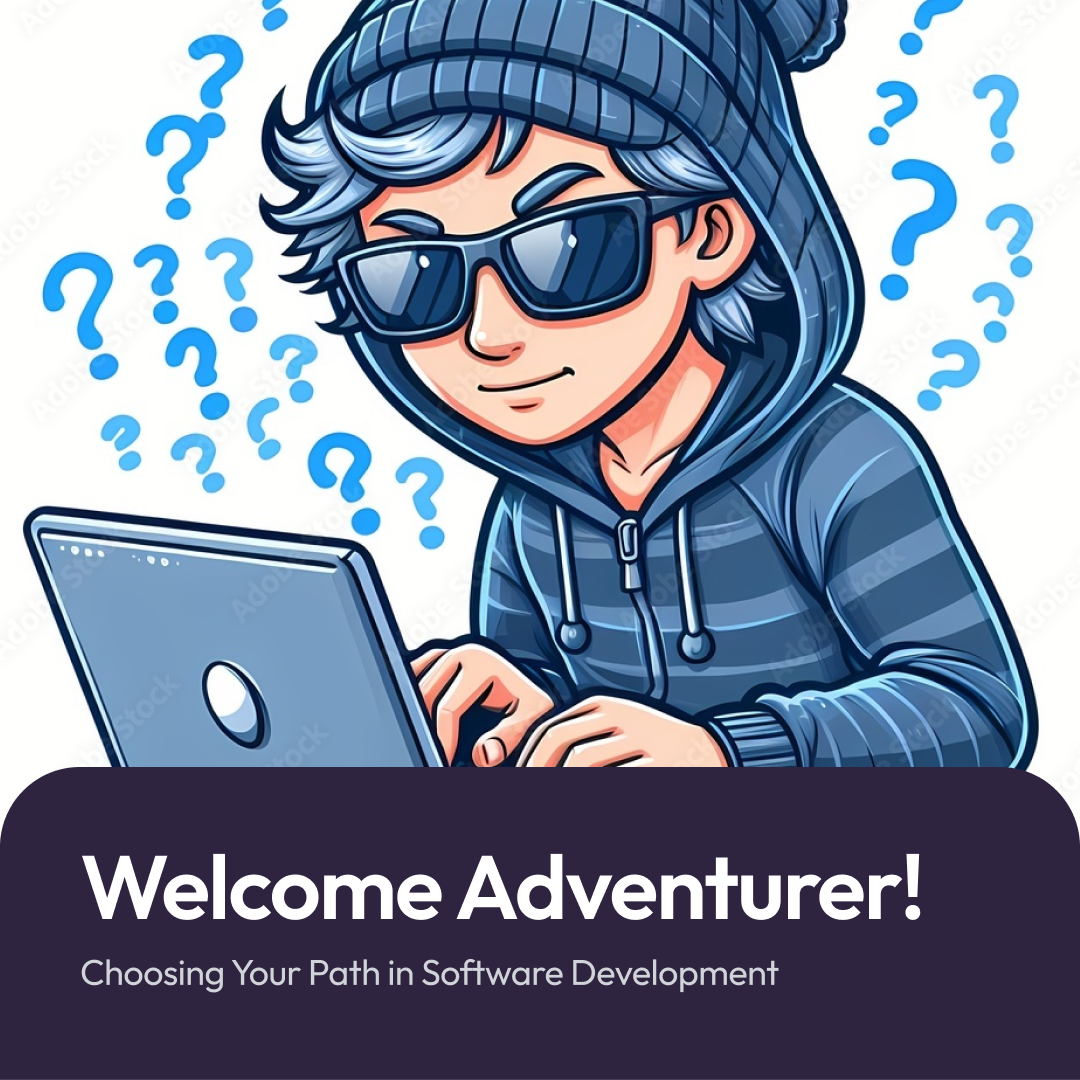Welcome, Adventurer! Choosing Your Path in Software Development
 Rod Lester Moreno
Rod Lester Moreno
Whether your quest leads you through the enchanted forests of JavaScript, the towering mountains of Python, or the labyrinthine corridors of C++, each step you take will arm you with new knowledge and skills. As a novice coder, remember that every master was once where you are now—full of curiosity, brimming with potential, and ready to make their mark on this ever-evolving digital landscape. So, gather your tools, sharpen your wits, and prepare to dive into the magical and transformative craft of coding. The adventure awaits!
Choosing Your First Technology: Where to Start in the Vast Tech Landscape?

Welcome to the exciting world of software development! If you’re reading this, you’re likely at the beginning of your journey, filled with curiosity and perhaps a bit of uncertainty about which path to take. Fear not, for this guide aims to help you navigate the vast landscape of software development, using resources like roadmap.sh to illuminate your way.
Introduction
Brief overview of my journey in software development
Inspired by the anime “The Irregular at Magic High School,” I dived into the coding world through Codecademy. The allure of translating the magic I saw on screen into digital reality fueled my curiosity and passion. These early experiences laid the foundation for a more formal education in programming when I entered university. Although we were introduced to C++ in our first year, we never explored its depths. Instead, I found myself gravitating towards Python, which we used for computer graphics and visual computing. Additionally, we touched upon website design and development but did not delve significantly into it.
I leaned heavily on online resources, particularly tutorials on YouTube and Codecademy, to fill in the gaps left by my formal education. One of the most significant milestones in my journey was developing an Employee Management System using PHP for my first full stack project. This project served as a practical introduction to handling both the front-end and back-end aspects of web development and solidified my interest in pursuing this path further.
Eager to expand my toolkit, I eventually transitioned to using Laravel, a PHP framework that simplified many aspects of the development process. Reflecting on this journey, I often think about how much easier it could have been with structured guidance. A clear roadmap or mentor could have significantly accelerated my learning curve, allowing me to avoid unnecessary detours and better focus my efforts.
Importance of choosing the right path
In an industry that evolves rapidly, aligning your learning and development efforts with current market demands can make a significant difference. For instance, focusing on popular programming languages such as Python, JavaScript, or Java can open numerous opportunities in various domains like web development, data science, and enterprise applications. Moreover, selecting the right learning resources—whether it's bootcamps, online courses, or traditional college programs—can enhance your understanding and make the learning process more efficient.
It allows you to set realistic goals and measure your progress effectively. As you gain confidence and experience in a chosen niche, you can then diversify your skills, making it easier to adapt to new challenges and technological advancements. A well-chosen path not only accelerates your entry into the workforce but also builds a resilient foundation that can pivot with the shifting landscape of technology, making continuous learning and career growth much more attainable.
However, understanding software development is a prerequisite for choosing the right path, as it enables one to connect the dots and navigate the complexities effectively.
Understanding Software Development
Understanding the Landscape
Software development is a broad field with various specializations. Here are some primary paths you might consider:
Frontend Developer
Role: Focuses on the user interface and user experience.
Skills: HTML, CSS, JavaScript, and frameworks like React, Angular, or Vue.js.
Typical Tasks: Building responsive web pages, ensuring cross-browser compatibility, and enhancing user interaction.
Career Prospects: Frontend developers are always in demand as they create the visible part of web applications.
Backend Developer
Role: Manages the server-side logic and integrates with databases and APIs.
Skills: Languages like JavaScript (Node.js), Python, Ruby, PHP, and frameworks like Laravel, Django, or Express.js.
Typical Tasks: Building and maintaining server-side applications, database management, and API development.
Career Prospects: Backend developers are essential for building robust and scalable web applications.
Full Stack Developer
Role: Combines both frontend and backend development skills.
Skills: A mix of frontend and backend skills, plus knowledge of databases, version control, and deployment processes.
Typical Tasks: Developing complete web applications, from UI to server logic and database integration.
Career Prospects: Full stack developers are versatile and highly valued for their comprehensive skill set.
DevOps
Role: Focuses on automating and streamlining the software development and deployment process.
Skills: Knowledge of CI/CD pipelines, containerization (Docker, Kubernetes), and cloud services (AWS, Azure, Google Cloud).
Typical Tasks: Managing infrastructure, automating deployments, and monitoring application performance.
Career Prospects: DevOps engineers are crucial for modern, agile development environments.
Mobile Development
Role: Specializes in developing applications for mobile devices.
Skills: Swift/Objective-C for iOS, Kotlin/Java for Android, and cross-platform tools like Flutter or React Native.
Typical Tasks: Building mobile apps, optimizing performance for different devices, and ensuring a seamless user experience.
Career Prospects: With the rise of mobile usage, mobile developers are in high demand.
Data Scientist
Role: Specializes in analyzing and interpreting complex data to help organizations make informed decisions.
Skills: Proficiency in programming languages like Python and R, knowledge of statistical methods, machine learning algorithms, data visualization tools (e.g., Tableau, Power BI), and databases (SQL, NoSQL).
Typical Tasks: Collecting and cleaning data, performing exploratory data analysis, building predictive models, visualizing data insights, and communicating findings to stakeholders.
Career Prospects: With the increasing reliance on data-driven decision-making, data scientists are in high demand across various industries.
Identifying Your Interests and Strengths
Self-assessment
Before diving into any specific path in software development, it's crucial to understand your own interests and strengths. Self-assessment can help you determine which area of software development aligns best with your personality and skills.
Personal Interests:
Consider what aspects of technology and development excite you the most. Do you enjoy creating visually appealing interfaces, or are you more fascinated by the logic and architecture behind the scenes? Are you passionate about data, or do you thrive in environments where you can automate processes?
Reflect on past projects or hobbies. What did you enjoy most? What aspects of those projects were the most fulfilling for you?
Technical Skills:
Evaluate your current technical skills. Are you more proficient in certain programming languages or technologies? Do you have a strong foundation in front-end or back-end development, data analysis, or mobile app development?
Identify the skills you excel in and the areas where you might need further improvement or training.
Problem-Solving Style:
Think about how you approach problem-solving. Do you prefer logical, step-by-step solutions, or do you enjoy creative, out-of-the-box thinking? Are you detail-oriented, or do you prefer to focus on the bigger picture?
Understanding your problem-solving style can help you choose a path that suits your natural tendencies and strengths.
Researching different roles
Once you have a better understanding of your interests and strengths, it's time to research the various roles available in software development. This will help you identify which roles align best with your self-assessment.
Job Descriptions:
Look up job descriptions for different roles in software development, such as front-end developer, back-end developer, full stack developer, DevOps engineer, mobile developer, and data scientist.
Pay attention to the responsibilities and day-to-day tasks associated with each role. This will give you a better idea of what to expect in each position.
Required Skills and Technologies:
Identify the skills and technologies commonly required for each role. This can include programming languages, frameworks, tools, and methodologies.
Compare these requirements with your own skill set. Are there areas where you already excel, or are there skills you need to develop further?
Work Environment and Culture:
Consider the typical work environment and culture associated with each role. For example, front-end developers often work closely with designers and have a strong focus on user experience, while back-end developers may focus more on server-side logic and databases.
Think about what type of work environment you thrive in. Do you prefer collaborative team settings, or do you enjoy working independently? Are you comfortable working in fast-paced environments, or do you prefer a more structured and stable setting?
Here are some of the websites you can browse for these information:
LinkedIn - LinkedIn is the world's largest professional network on the internet.
Indeed - Indeed is the #1 job site in the world with over 350M unique visitors every month.
Choosing Your Path
Assess Your Interests and Strengths
Do you enjoy creating visually appealing interfaces? Frontend development might be for you.
Are you fascinated by server logic and data management? Consider backend development.
Do you want to be a jack-of-all-trades? Full stack development could be your calling.
Are you passionate about automation and infrastructure? DevOps might suit you.
Are you excited about mobile technology? Mobile development is a great choice.
Explore and Experiment
Take introductory courses in different areas. Platforms like Codecademy, Coursera, and freeCodeCamp offer great resources.
Build small projects to get hands-on experience and see what you enjoy most.
Utilize Roadmaps
- roadmap.sh offers comprehensive guides and roadmaps for various developer paths. These resources outline the skills and technologies you need to learn, providing a structured learning path.
Getting Started
Learn the Basics
- Regardless of your chosen path, start with the fundamentals of programming. Learn about variables, data structures, algorithms, and basic programming concepts.
Choose a Path and Dive Deeper
- Once you’ve decided on a path, focus on the specific skills required. Follow the roadmaps on roadmap.sh to guide your learning journey.
Build Projects
- Apply what you’ve learned by building projects. Start small and gradually take on more complex challenges.
Join a Community
- Engage with other developers through forums, social media, and local meetups. Communities like Stack Overflow, GitHub, and Reddit are great places to ask questions, share knowledge, and get support.
Keep Learning
- Technology is always evolving. Stay updated with the latest trends and continuously improve your skills.
Final Thoughts
Choosing a path in software development is a personal decision that should align with your interests and career goals. Take your time to explore, experiment, and learn. The journey may seem daunting, but with determination and the right resources, you’ll find your place in the software development world.
Happy coding!
Recommended Resource
Subscribe to my newsletter
Read articles from Rod Lester Moreno directly inside your inbox. Subscribe to the newsletter, and don't miss out.
Written by
